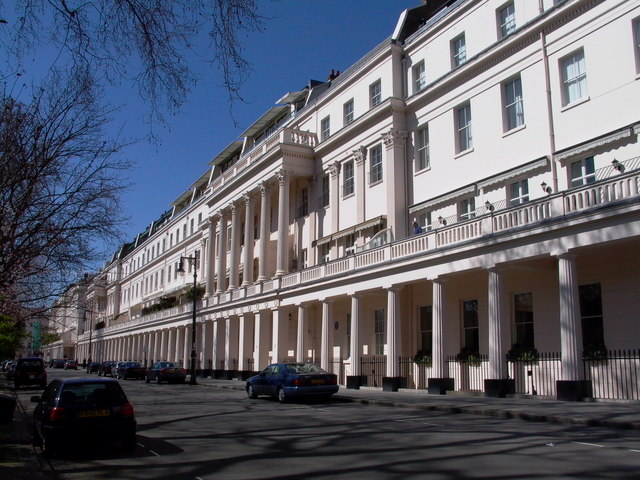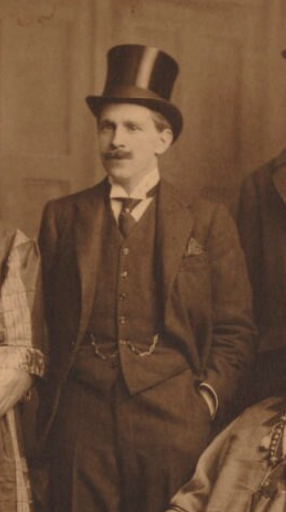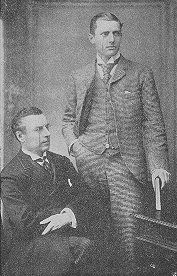|
Alfred Clayton Cole
Alfred Clayton Cole (17 December 18545 June 1920) was a City of London merchant and director of the Bank of England, serving as Governor of the Bank of England from 1911 to 1913. Early life and background The younger son of William Henry Cole, a banker and merchant trading with the Americas, with premises in Gracechurch Street, in the City of London,''Chemist and Druggist: The Newsweekly for Pharmacy'', Volume 34 (1889), p. 799: "The late Mr. William Henry Cole, whose death we briefly announced in our last issue, was born at Pulham in 1819, and... still carrying on business as American merchants and bankers at 85 Gracechurch Street, E.C." the young Cole was educated at Eton and Trinity College, Cambridge, then in 1880 entered his father's business in London, W. H. Cole & Son.Youssef Cassis, ''Banquiers de la City à l'époque Édouardienne'' (1994), p. 89 In 1882 he was listed in the ''Webster's Court and Fashionable Register'' with an address at 64, Portland Place. At Eton, Col ... [...More Info...] [...Related Items...] OR: [Wikipedia] [Google] [Baidu] |
Governor Of The Bank Of England
The governor of the Bank of England is the most senior position in the Bank of England. It is nominally a civil service post, but the appointment tends to be from within the bank, with the incumbent grooming their successor. The governor of the Bank of England is also chairman of the Monetary Policy Committee, with a major role in guiding national economic and monetary policy, and is therefore one of the most important public officials in the United Kingdom. According to the original charter of 27 July 1694 the bank's affairs would be supervised by a governor, a deputy governor, and 24 directors. In its current incarnation, the bank's Court of Directors has 12 (or up to 14) members, of whom five are various designated executives of the bank. The 121st and current governor is Andrew Bailey, who began his term in March 2020. Governors of the Bank of England (1694–present) See also * Chief Cashier of the Bank of England * Deputy Governor of the Bank of England References ... [...More Info...] [...Related Items...] OR: [Wikipedia] [Google] [Baidu] |
St James's Club
The St James's Club was a London gentlemen's club which operated between 1857 and 1978. It was founded by two leading diplomats and its members continued to be largely diplomats and authors. It was first established in Charles Street and moved to 106 Piccadilly by 1868. In the final quarter of the twentieth century many gentlemen’s clubs of London suffered from declining membership, and in 1978 the St James's Club merged with Brooks's Club and vacated its premises. Foundation The club was founded in 1857 by the Liberal statesman the second Earl Granville and by the Marchese d'Azeglio, Minister of Sardinia to the Court of St. James's, after a dispute at the Travellers' Club. Most members of the diplomatic corps resigned from the Travellers' and joined the new club. The club's members continued to be largely diplomats and authors, and it became the home of the Dilettanti Society. The name ''St James’s Club'' had previously been used by William Crockford as the official name of ... [...More Info...] [...Related Items...] OR: [Wikipedia] [Google] [Baidu] |
Eaton Square
Eaton Square is a rectangular, residential garden square in London's Belgravia district. It is the largest square in London. It is one of the three squares built by the landowning Grosvenor family when they developed the main part of Belgravia in the 19th century that are named after places in Cheshire — in this case Eaton Hall, the Grosvenor country house. It is larger but less grand than the central feature of the district, Belgrave Square, and both larger and grander than Chester Square. The first block was laid out by Thomas Cubitt from 1827. In 2016 it was named as the "Most Expensive Place to Buy Property in Britain", with a full terraced house costing on average £17 million — many of such town houses have been converted, within the same, protected structures, into upmarket apartments. The six adjoining, tree-planted, central gardens of Eaton Square are Grade II listed on the Register of Historic Parks and Gardens. All of the buildings (№s 1–7, 8-12A, ... [...More Info...] [...Related Items...] OR: [Wikipedia] [Google] [Baidu] |
Probate
Probate is the judicial process whereby a will is "proved" in a court of law and accepted as a valid public document that is the true last testament of the deceased, or whereby the estate is settled according to the laws of intestacy in the state of residence of the deceased at time of death in the absence of a legal will. The granting of probate is the first step in the legal process of administering the estate (law), estate of a deceased person, resolving all claims and distributing the deceased person's property under a will. A probate court decides the legal validity of a testator's (deceased person's) will and grants its approval, also known as granting probate, to the executor. The probated will then becomes a legal instrument that may be enforced by the executor in the law courts if necessary. A probate also officially appoints the executor (or personal representative), generally named in the will, as having legal power to dispose of the testator's assets in the manner sp ... [...More Info...] [...Related Items...] OR: [Wikipedia] [Google] [Baidu] |
Pulham Market
Pulham Market is a village and civil parish in Norfolk, situated approximately northeast of Diss and south of Norwich. It covers an area of and had a population of 999 in 443 households as of the 2001 census, the population falling to 977 at the 2011 Census. The name 'Pulham' means 'pool homestead/village' or 'pool hemmed-in land'. The nearest railway station is Diss. It once had its own station on the Waveney Valley Line which is now closed. The long-distance footpath Boudica's Way runs through the village. Older maps and documents name the parish or village "Pulham Saint Mary Magdalene" after the dedication of its parish church. The neighbouring parish and village was historically known as "Pulham Saint Mary the Virgin" after the dedication of its own parish church, though is these days typically abbreviated to Pulham St Mary. The earliest recorded spelling is PollehamPulhamis referenced in the Domesday Book of 1086 as a single manor (including both Pulham Market and ... [...More Info...] [...Related Items...] OR: [Wikipedia] [Google] [Baidu] |
The Times
''The Times'' is a British daily national newspaper based in London. It began in 1785 under the title ''The Daily Universal Register'', adopting its current name on 1 January 1788. ''The Times'' and its sister paper ''The Sunday Times'' (founded in 1821) are published by Times Newspapers, since 1981 a subsidiary of News UK, in turn wholly owned by News Corp. ''The Times'' and ''The Sunday Times'', which do not share editorial staff, were founded independently and have only had common ownership since 1966. In general, the political position of ''The Times'' is considered to be centre-right. ''The Times'' is the first newspaper to have borne that name, lending it to numerous other papers around the world, such as ''The Times of India'', ''The New York Times'', and more recently, digital-first publications such as TheTimesBlog.com (Since 2017). In countries where these other titles are popular, the newspaper is often referred to as , or as , although the newspaper is of nationa ... [...More Info...] [...Related Items...] OR: [Wikipedia] [Google] [Baidu] |
West Woodhay House
West Woodhay House is a Grade I listed building in the parish of West Woodhay, West Berkshire, UK. History and description The house was erected in 1635 and is attributed to Inigo Jones, although it is likely to have been designed and built by Edward Carter. East facing, it looks over a lawn and an ornamental lake beyond. It has two storeys of red brick with a central hall and projecting end wings. The porch has a rounded arch, which is flanked by Ionic pillars. Over the porch doorway is the date 1635 with the motto, ''Nisi Dominus aedificet Frustra'', a shortened version of Psalm 127, verse 1: ''Without the Lord, he builds in vain'', which, slightly altered, is also the motto of the city of Edinburgh. The poet and politician Sir Benjamin Rudyerd lived in the house and died there in 1658. In the eighteenth century, West Woodhay House was owned by William Sloper, MP, followed by his son William Sloper, who lived there with the soprano Susannah Cibber following her estrangement ... [...More Info...] [...Related Items...] OR: [Wikipedia] [Google] [Baidu] |
Horace De Vere Cole
William Horace de Vere Cole (5 May 1881 – 25 February 1936) was an eccentric prankster born in Ballincollig, County Cork, Ireland. His most famous prank was the ''Dreadnought'' hoax where he and several others in blackface, pretending to be an Abyssinian prince and his entourage, were given a tour of the Royal Navy ship HMS ''Dreadnought''. Family background and early life Cole was the son of British Army officer William Utting Cole, a major in the 3rd Dragoon Guards who died of cholera in India when his son was a child. His mother, Mary de Vere, was niece and heiress of politician Sir Stephen de Vere, 4th Baronet. Cole was a great-nephew of the Anglo-Irish poet Aubrey de Vere. Horace's paternal grandfather had made his fortune dealing in quinine, while his mother's family claimed kinship with the de Vere Earls of Oxford and the right to the position of Lord Great Chamberlain of England. A bout of diphtheria at the age of ten seriously affected his hearing for the remain ... [...More Info...] [...Related Items...] OR: [Wikipedia] [Google] [Baidu] |
Neville Chamberlain
Arthur Neville Chamberlain (; 18 March 18699 November 1940) was a British politician of the Conservative Party who served as Prime Minister of the United Kingdom from May 1937 to May 1940. He is best known for his foreign policy of appeasement, and in particular for his signing of the Munich Agreement on 30 September 1938, ceding the German-speaking Sudetenland region of Czechoslovakia to Nazi Germany led by Adolf Hitler. Following the German invasion of Poland on 1 September 1939, which marked the beginning of the Second World War, Chamberlain announced the declaration of war on Germany two days later and led the United Kingdom through the first eight months of the war until his resignation as prime minister on 10 May 1940. After working in business and local government, and after a short spell as Director of National Service in 1916 and 1917, Chamberlain followed his father Joseph Chamberlain and elder half-brother Austen Chamberlain in becoming a Member of Parliament in t ... [...More Info...] [...Related Items...] OR: [Wikipedia] [Google] [Baidu] |
Anne Chamberlain
Anne de Vere Chamberlain (; 1883 – 12 February 1967) was the wife of British Prime Minister Neville Chamberlain. A successful businessman when they married, he credited her with encouraging him into political life, and rising to the premiership. Biography Anne de Vere Cole was born to Major William Utting Cole, of West Woodhay House, Berkshire. Her mother, Mary de Vere, was Irish, and traced her descent to the 15th Earl of Oxford; she inherited Issercleran, Craughwell, County Galway, in 1888. Her brother was the noted prankster Horace de Vere Cole (1881–1936), who inherited the family seat sometime after 1889; it was later owned by John Huston and then Merv Griffin and is now known as St Cleran's House. From childhood Anne loved to travel, going abroad each year, later going to Canada and East Africa as a married woman. She married Neville Chamberlain in January 1911, and remained his wife until his death in November 1940. At the time of her marriage her husband, a su ... [...More Info...] [...Related Items...] OR: [Wikipedia] [Google] [Baidu] |
Joseph Chamberlain
Joseph Chamberlain (8 July 1836 – 2 July 1914) was a British statesman who was first a radical Liberal, then a Liberal Unionist after opposing home rule for Ireland, and eventually served as a leading imperialist in coalition with the Conservatives. He split both major British parties in the course of his career. He was the father, by different marriages, of Nobel Peace Prize winner Austen Chamberlain and of Prime Minister Neville Chamberlain. Chamberlain made his career in Birmingham, first as a manufacturer of screws and then as a notable mayor of the city. He was a radical Liberal Party member and an opponent of the Elementary Education Act 1870 on the basis that it could result in subsidising Church of England schools with local ratepayers' money. As a self-made businessman, he had never attended university and had contempt for the aristocracy. He entered the House of Commons at 39 years of age, relatively late in life compared to politicians from more privileged backg ... [...More Info...] [...Related Items...] OR: [Wikipedia] [Google] [Baidu] |
St George's Hanover Square Church
St George's, Hanover Square, is an Anglican church, the parish church of Mayfair in the City of Westminster, central London, built in the early eighteenth century as part of a project to build fifty new churches around London (the Queen Anne Churches). The church was designed by John James; its site was donated by General William Steuart, who laid the first stone in 1721. The building is one small block south of Hanover Square, near Oxford Circus. Because of its location, it has frequently been the venue for society weddings. Ecclesiastical parish A civil parish of St George Hanover Square and an ecclesiastical parish were created in 1724 from part of the ancient parish of St Martin in the Fields. The boundaries of the ecclesiastical parish were adjusted in 1830, 1835 and 1865 when other parishes were carved out of it. The ecclesiastical parish still exists today and forms part of the Deanery of Westminster St Margaret in the Diocese of London. Architecture The la ... [...More Info...] [...Related Items...] OR: [Wikipedia] [Google] [Baidu] |







